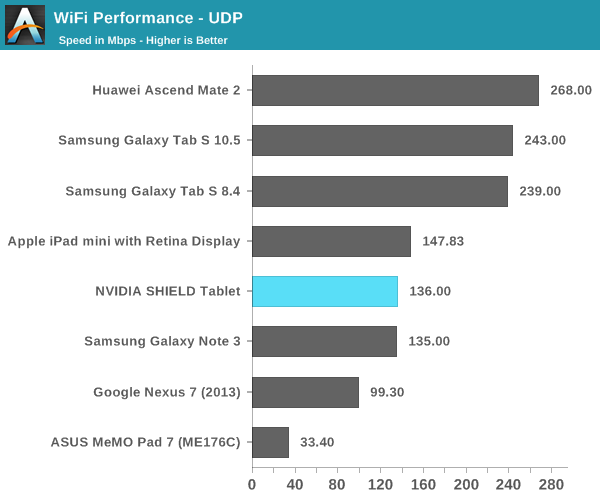The NVIDIA SHIELD Tablet Review
by Joshua Ho on July 29, 2014 9:00 AM ESTWiFi Performance
For the most part these days it seems that the situation for WiFi is much better in mobile than it is anywhere else, but it's still important to test throughput, especially on a device like the Shield tablet that requires low latency, high bandwidth connections in order to support GameStream and GRID. To this end, while NVIDIA hasn't shipped 802.11ac the Shield tablet ships with a 2x2 antenna configuration for a maximum PHY rate of 300 Mbps. Like the Shield portable, this is a BCM43241 chip, likely shared to improve economies of scale. To look at how it performs, we turn to iperf. Before we get into the results of the test, I'd like to thank ASUS for providing the RT-AC68U router to test WiFi perfomance.

Surprisingly, the Shield tablet performs about as well as some single stream 802.11ac solutions like the one found in the Galaxy Note 3. Performance is generally in line with what we'd expect for such a solution, although it would be nice to see 802.11ac for future products.
Camera
While I currently don't have the means to properly test camera, there are still some things to talk about for camera. Both the front and rear camera modules use OmniVision's OVT5963 sensor, which appears to be a 1/4", 5MP sensor. The rear camera has an F/2.0 aperture with 2.95mm focal length, and the front camera has an F/2.8 aperture, with a claimed 4.76mm focal length, although the field of view appears to be somewhat wider. This is the same sensor as the camera in the Nexus 7 (2013). As a rear facing camera, the quality is nothing special but as a front facing camera it's surprisingly high quality. The photo above is with the rear facing camera, the photo below is from the front facing camera. The stock camera application also doesn't show the correct aspect ratio for the camera, so the preview is cropped.
Audio
While I don't have the equipment available to test audio quality and peak volume quite yet, subjectively the two bass reflex ports and dual front facing speakers make for a great experience. It's definitely a major advantage over other devices when it comes to watching movies and playing games as I don't have to cup my hand around the speaker. The larger size of the tablet formfactor means that the stereo separation is much more obvious. On the headphone jack, the device appears to be using a Realtek RT5639 codec. It seems that NVIDIA has continued to use their own speaker protection system that runs on the SoC, as there isn't any clear evidence of a speaker protection IC connected via I2C.












174 Comments
View All Comments
Stuka87 - Tuesday, July 29, 2014 - link
I think the tablet on its own is decent. Although it is very heavy for its size (Which BTW this review does not mention its weight anywhere).The controller is what I end up scratching my head over. In their release photos they show a girl gaming with the tablet, but sitting like 3ft away. As if being that far away would be enjoyable.
One other thing that is not clear, if the tablet is NOT on wifi, will the controller still work? The article makes it sound like you have to be on wifi.
Friendly0Fire - Tuesday, July 29, 2014 - link
WiFi *Direct* is a straight connection between the tablet and the controller using the WiFI protocol. It most certainly doesn't need a network to work.Stuka87 - Tuesday, July 29, 2014 - link
Hm, ok. But he specifically said it depends what type of wifi network you are on.lmcd - Tuesday, July 29, 2014 - link
That's for the connection band. Meaning that if one of the two Wi-Fi bands is in use for Wi-Fi, then the other one is the one that'll be used for the Wi-Fi direct.halca - Tuesday, July 29, 2014 - link
Really? That's it for the directstylus review section? I'm disappointed. I hoped to see more comparison between the old and new, and compared to wacom's tech on samsung note line.scbundy - Tuesday, July 29, 2014 - link
Shame about the screen, but with my old Nexus 7 broken and me looking for a gaming tablet replacement, this one appears to fit the bill perfectly. Especially since my gaming PC has a 780 GTX. Can't wait to try it out.dabotsonline - Tuesday, July 29, 2014 - link
"In essence, this device is already ready to serve as an Android TV device."I thought that Google are mandating a very specific UI design for Android TV devices - one which is very different from this? Do you have any inside info regarding the final version this fall / autumn, Josh?
aamir147 - Tuesday, July 29, 2014 - link
I think he means nvidia can eventually add an android TV mode when connecting via hdmi just like you can get a console mode.SpartyOn - Tuesday, July 29, 2014 - link
Personally, I love my Shield Portable (or whatever they're calling the 1st Gen device). Sitting in bed or on the couch streaming the game I just turned off at my desk is fantastic. It's also the best Android emulator device out there.The recent updates to allow outside the home streaming (which this article incorrectly states as only allowing in-home; please change) and 1080p Console Mode streaming via wired Ethernet, have made this a killer mobile gaming device. Instead of carting my mITX build back and forth when I want to play a game via controller on my HDTV, I can now simply hook up the Shield and stream the game, in full 1080p, to the TV and can hook up an XBOX 360 wireless controller with USB OTG. No more hauling a computer around the house or having to settle for a laptop! Seriously awesome.
My wife and I continuously fight to use the Shield when heading to bed, she for her emulators and me for streaming from my gaming rig. I REALLY want to pick up another one so that she can have her own, so I was hoping this was going to be a self-contained device like the 1st Gen, just with the K1 and maybe some weight balancing, an extra miniUSB port, and a 6" screen with less bezel (the bezel with the 5" is HUGE and I'm sure they could creatively get a slightly bigger screen in there).
Unfortunately, the new Shield device as a tablet is... underwhelming. Sure it has snazzy bells n' whistles for a tablet, but with the larger form factor and lack of handholding ease, this really kills a lot of its portability. I prefer the fully contained controller/screen of the original; plus, it was different and really created a new market. Now it's just another tablet in a crowded field. Seems like a dumb strategy to me.
Until they release a refreshed Shield Portable with the K1, I'll be keeping my money. Kudos to NVIDIA though for the 1st Gen device - I love it.
fivefeet8 - Tuesday, July 29, 2014 - link
Unfortunately, you're probably in the minority at this point and I do understand why some would prefer it that way. One of the reasons I didn't get the original shield is because you couldn't do much else with it besides gaming. Even though I loved the hardware and software, I wanted something that could encompass more. Something I could use for both work and play on mobile. The new Shield Tablet fits that almost perfectly.